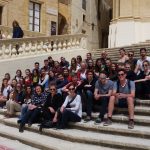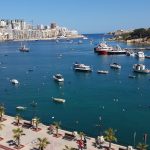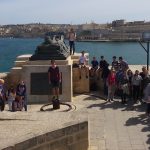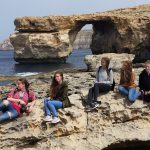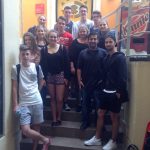The Country
As we were flying over Malta it was surprising to see how small the island is – it’s just about the size of Vienna. When we got off the plane, we immediately noticed the differences. In comparison to our green vegetation in Austria, Malta’s vegetation consists solely of palm trees, bushes and cactuses.
Nevertheless, the island is worth visiting because the sea is warm and beautiful, places like the Golden Bay sandy beach are marvelous and there are many historical sites and monuments from all periods of Maltese history. We visited impressive prehistoric stone temples, saw remnants of the Roman past, admired the colorful fishing boats with their Phoenician eyes and went into some of the 370 Catholic churches and chapels. We also took a stroll through the fortified capital of Valetta, which was built in the 16th century by the Maltese knights, and enjoyed various other cultural sites from the time when Malta was a British colony for about 150 years until 1964.
No doubt, you would enjoy a trip to Malta as well, but make sure to get off the road quickly if you hear a car’s horn, because the Maltese won’t stop just because somebody’s in the way…
The People
The Maltese are different, that’s for sure. Maybe the reason for this is the unique Italian, Arabic, continental European and British historical-cultural mix that has carved its impact on the island. The result: a nation of people that cannot really be compared to any other.
In general, the Maltese live a typical Mediterranean lifestyle, obviously. What we mean by this: The people don’t worry and just enjoy the moment; some old Maltese “cars” would not be allowed on Austrian streets; and there is no citizen-concern that now and then the streets resemble a huge waste dump.
In the restaurants the waiters didn’t worry themselves with efficient service or returning our change. (However, this became a pretty good excuse for being late ;))
Having said this, the 423 282 people on the island are in general open-minded and friendly. Every time we had to ask for directions (which was quite often) they were willing to help us out of our misery.
This sums up their attitude – friendly and kind as long as you are as well, but also pretty laid-back and relaxed when there is some stress on the way.
The Language
The Maltese language is the only Semitic language (meaning sort of “Arabic language”), which is written in Roman letters. It’s fairly hard to pronounce and sounds quite funny. We learned two Maltese words whilst there: the first, “Triq,” meaning “street” (produce the >q< as a glottal stop in your throat) and secondly “Saħħa,” which means goodbye, the sound in the middle being a fricative similar to our “Sacher”. Over the course of the centuries the Maltese have integrated many Italian and English words into their everyday language, so today one can also say “Ciao” to say goodbye. 😉 All people in Malta speak both Maltese and English, although their English is often not exactly like standard Oxford English J, which we could notice in our lovely host families.
The Host Families
From busy working mums to strict and distrustful individuals to attentive granddads – we had it all! Our insight into the daily lives of the Maltese people were as different as we are. As we were staying with host families we had the chance to experience the lifestyle and living conditions of the natives first hand.
The wide variety of our host families meant that we all had different impressions which brought together the adventure. This meant that all of us could tell interesting and humorous stories about their new “homes”. It is fair to say that no one really had bad luck with his/her host because all initial uncertainties were discarded and everyone was willing to work to solve any problems. Overall, the majority of us are able to reflect on an interesting and experience-gaining stay in a different cultural surrounding.
The School
From the outset we knew that our week in Malta was for language reasons (not just to be a nice holiday trip), and so we also had to go to school. In total we had English lessons for four half days but school did not start before 9 am. (So you poor ones here in Austria already had to be at school whilst we were still sleeping soundly to the sound of the Mediterranean waves J)
Fortunately, the course was not as hard as we had expected. This was mainly down to our teachers, who were really friendly, skilled and always cheerful, which of course was down to us smart students as well ;). Not only the staff but also the location was great. By Maltese standards the building was welcoming, modern and clean (except for the rather disgusting smell in the toilets). We could even enjoy our free time during the breaks on the rooftop terrace, which boasted a cafeteria and a marvelous view over the city.
The Day Trips
Since 31st of March is a national holiday in Malta, we had the chance to devote three full days to visiting the island and their most important monuments. We were shown around by our tour guide for the week, good ol’ Joe. From the capital city of Valletta, the cities of Mdina and Rabat, to the island of Gozo – we saw it all! Of course we couldn’t skip the opportunity to visit the famous Neolithic temples of Malta and seven of us even decided to use our free afternoon to explore St. John’s Co-Cathedral in Valletta together with Prof. Denkmayr. Here we also treated ourselves to some delicious Maltese ice cream and took glorious selfies with our teacher, with whom we also had a heated discussion about who the heck this “Claudia” was he was talking about. Telling us “Heit is Claudia!” – we then found out that he actually meant “Heute ist es cloudier als gestern” (!) Remember kids, don’t do Denglish!
The Food
If you love whole-meal bread, Malta is the wrong place to go. This was our first observation at breakfast. However, if you are fond of traditional pies filled with meat, cheese or spinach, or if you are an adventurous foodie wanting to try Maltese “Pastizzi”, you will not be disappointed. Fast food meals and chips featured at the top of Malta daily menus – these are foods you can either choose to enjoy or avoid. For those of us craving a different cuisine to the English influenced one, the delicious Italian food was the best remedy we could find. So, at the end of each day we were all happy to say, “Thank you for the eat!” (inside joke!)
Going out
Malta’s nightlife is mostly centered in Paceville, the neighboring city of Sliema, where we stayed. Besides going to a bowling centre and to the cinema we could also do some shopping or enjoy ourselves in one of the countless bars along the main street. Sometimes we could hear loud beats and music and we just had to go dancing all night long (well – just until our curfew at 23:00). We noticed that all the people were more open-minded and sociable than we are used to in Austria and therefore it was easier to start a conversation and speak English. We also got to know a lot of new friends from different countries. When we didn’t want to go to this "party mile" we chilled in Sliema in a bar by the sea, especially during Happy Hour where you got two cocktails for the price of one (which of course were all non-alcoholic!)
Resumé
All in all, we got to spend a wonderful, yet exhausting week in Malta. It’s safe to say that it was a trip which all of us will remember sitting in our rocking chairs 50 years from now. If our previously mentioned points did not convince you of the beauty of this special little island then we don’t know what will. Well… except maybe seeing it for yourself 😉
- Mdina
- Sliema
- Valetta
- Megalithic temple
- Azure window
- At school
- South of Malta
![b[r]g Enns](https://www.brgenns.ac.at/wp-content/uploads/2016/06/cropped-brgenns.png)
